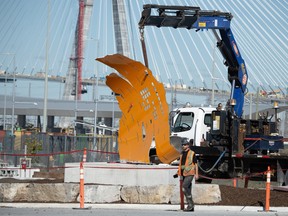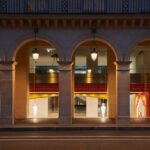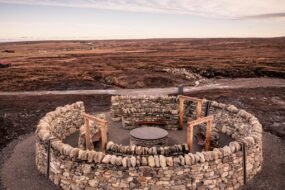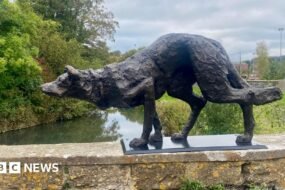
Article content
Curling metal birch bark standing three metres high and rooted in Indigenous culture will greet travellers entering and exiting the Gordie Howe International Bridge on the Canadian side, thanks to an Anishinaabe artist.
The towering sculpture by Michael Belmore was installed near the new tolling area this week and will be visible to thousands of bridge users going both directions once the new border crossing opens.
Article content
Titled Aazhoge, the Anishinaabe word for bridge — also meaning to cross over, to travel, or see many levels — the birch bark sculpture includes an image of a thunderbird with three flames coming out of its mouth, representing the Three Fires Confederacy. Woodpecker holes in the bark spell out the sculpture’s title in partial binary code.
One side of the work is orange, and the other silver, so those who enter Canada will see it differently from those leaving.

“Birch bark, for Anishinaabe people, Indigenous people, it’s important,” Belmore told the Star on Thursday. “It’s what we travelled with. It was our canoes, our wigwams, our houses. It was the scrolls that we wrote and transcribed knowledge onto — it was a vehicle for many different ways of being.
“I wanted to represent that as a connection to the bridge, because the bridge speaks to that history.”
It’s Belmore’s first piece where he had to outsource a sculpture’s fabrication. Made out of three-quarter-inch stainless steel, the sculpture material was not something Belmore could bend in his studio, he said.
Belmore is from the Thunder Bay region and attended the Ontario College of Art in the 1990s. He’s been a full-time artist — always in sculpture — since then.
Article content
About four years ago, Belmore applied to create a piece for the Gordie Howe and was shortlisted before being awarded the commission.
“It was an amazing opportunity,” Belmore said. “It’s really interesting, because it’s a secure site, not like other sculptures that I have where people can go and stand beside it and touch it.
“There’s no getting out here and going over and looking at it and touching it — it’s very transitory. It’s about travel, so it’s always a kind of signpost.”
Members of the local First Nations community said they wanted the new bridge to celebrate and recognize Indigenous heritage during public consultation sessions held between 2005 and 2008, said Heather Grondin, chief relations officer with the Windsor-Detroit Bridge Authority.
“Now, all these years later, we’re able to actually implement that through this (art),” Grondin said. “The opportunity to have thousands of people drive by this, reflect on it, celebrate, be educated, and create awareness about Indigenous history and culture, that’s such a wonderful achievement and goal for us.
“We’ve always tried to make this bridge about more than meeting the transportation goals, which, of course, is incredibly important.
“But integrating beauty into this transportation infrastructure has also been important to us.”
The bridge is scheduled to open in the fall of 2025, though Canadian Housing, Infrastructure and Communities Minister Sean Fraser hinted an earlier opening date might be possible during a visit to the crossing over the summer.
Share this article in your social network









